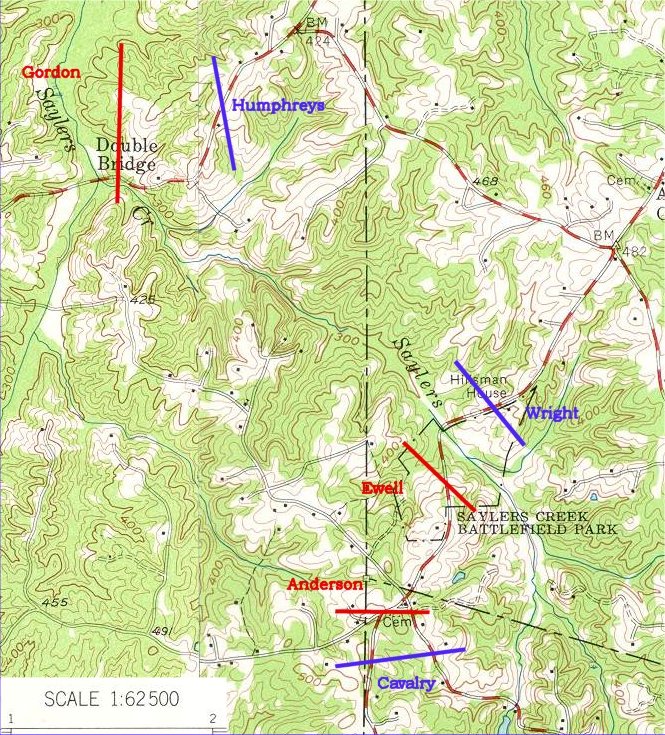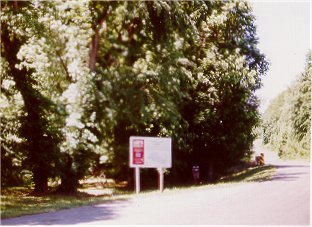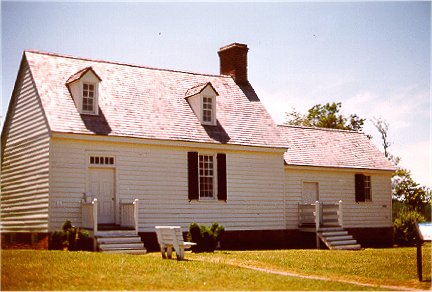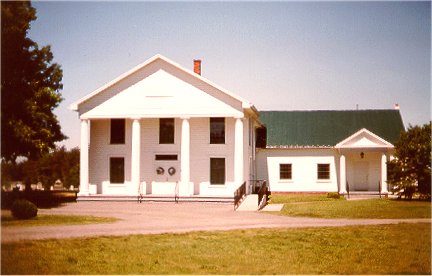
Saylor's Creek
April 6, 1865
After the disasters at Five Forks and the Petersburg Breakthrough, Lee had no alternative but to withdraw from Petersburg and Richmond. Lee moved west in the hopes of joining Joe Johnston in North Carolina to defeat Sherman and Grant separately. There was little to no hope of success, and desertion severely depleted the ranks. After attempts to move south were foiled, Lee decided to head for Farmville. There he planned to re-supply and head south, but Grant kept up the pressure throughout the march. The Confederates held High Bridge across the Appomattox against a Union raiding party, keeping their line of retreat open for now.
| Lee's army became spread out in a desperate attempt to stay ahead of the Federals. The running fight became more serious on April 6th. Union cavalry separated the Confederate advance guard under Longstreet from Anderson's corps and pinned down Anderson. Behind Anderson was Ewell's command, the troops that had defended Richmond. The Union VI Corps under Horatio Wright was ordered to deploy and attack Ewell's isolated command. Ewell directed the baggage train north to Gordon's corps, which was being pursued by the Union II Corps under Humphreys. |
 |

From Hillsman House
Wright deployed the 10,000 men of the VI Corps along this ridge near the Hillsman House. In the distance, Ewell was deploying his 3,600 along a parallel ridge beyond Saylor's Creek. At about 5:30PM, after a half hour bombardment, the VI Corps advanced.

Ewell's Position
Union troops crossed the flooded creek and continued the advance. The attackers encouraged the Confederates to surrender but were met with a devastating volley. The Yankees broke and the Confederates counterattacked, but they too were driven back. A second attack overlapped Confederate flanks and overwhelmed Ewell. Four hundred Confederates were killed or wounded and three thousand were captured.

Double Bridges
The wagon train sent north to Gordon's column got jammed up when one of two nearby bridges collapsed. Gordon's men deployed to protect the wagons but could not hold off the Union II Corps. The Confederates fell back to the creek and used the wagons for protection. When a flanking column was detected, Gordon's men fled the field and up the hill visible in the picture, having abandoned the wagons.

Hillsman House
As the battle came to a close, Union cavalry smashed Anderson's corps, completing the day's destruction. Lee had lost 7,700 of his nearly 17,000 remaining men, including six generals captured. The Union army lost just under 1,200 of its 36,000 men. The wounded were cared for here at the Hillsman House.
What remained of Lee's army continued the retreat to Farmville, with Anderson and Longstreet continuing on the south bank of the Appomattox while Gordon crossed to the north side at High Bridge.

Cumberland Church
The next day, Lee's resupply at Farmville was interupted by Union cavalry. Meanwhile, the Confederates failed to adequately burn High Bridge and the II Corps remained in contact. Here at Cumberland Church north of Farmville these Union troops struck Lee again. Despite 570 Union casualties, the Confederate army remained unbroken. That night, Grant sent Lee his first note suggesting surrender. Lee refused, and continued his retreat west. The next day, April 9th, Lee was cut off at Appomattox Courthouse. When a breakout attempt failed, he surrendered his army. Although the fighting continued elsewhere, the surrender at Appomattox essentially ended the war.
Back to Civil War Virtual Battlefield Tours